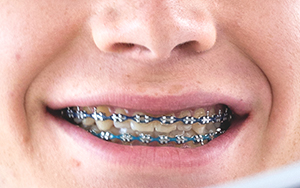Your Guide to Cumming Invisalign: Straightening Teeth with Style and Convenience
Your Guide to Cumming Invisalign: Straightening Teeth with Style and Convenience
Blog Article
A Closer Take A Look At Different Orthodontics Procedures and Their Benefits in Dental Treatment
Orthodontic treatments play an essential role in enhancing dental health and boosting the general looks of one's smile. From standard dental braces to modern clear aligners, the field of orthodontics offers an array of treatment options tailored to meet specific demands. Each approach includes its own collection of benefits, attending to numerous alignment problems and offering services that accommodate various choices and lifestyles. Recognizing the subtleties of these procedures and their corresponding advantages can encourage individuals to make informed decisions about their dental health and wellness.

Typical Braces: Positioning Improvement Method
Using the reliable method of conventional dental braces, orthodontic professionals successfully proper misalignments of the teeth and jaw to bring back ideal oral health and function. Conventional dental braces contain metal brackets that are stuck to the teeth and attached by wires and elastic band. This system applies gentle stress to slowly change the teeth into their appropriate placements over time.
One of the primary benefits of standard braces is their flexibility in treating different oral problems, including congested teeth, gaps, crossbites, overbites, and underbites. By dealing with these misalignments, braces not only improve the aesthetic look of the smile yet likewise improve generally oral wellness. Properly straightened teeth are much easier to cleanse, minimizing the threat of cavities, periodontal illness, and various other dental issues.
While modern-day orthodontic advancements provide options like clear aligners, conventional braces continue to be a cost-effective and reputable solution for complex positioning concerns. Orthodontists thoroughly customize treatment plans to suit each person's one-of-a-kind needs, ensuring effective and successful results in accomplishing a straighter, much healthier smile.
Invisalign: Clear Aligners for Discreet Therapy
While traditional braces have long been a best technique for dealing with oral misalignments, Invisalign clear aligners provide a very discreet alternative for achieving straighter teeth and a healthier smile. Invisalign aligners are practically unnoticeable, making them a popular choice for individuals that choose an even more cosmetically pleasing orthodontic treatment alternative.
These clear aligners are personalized to fit well over the teeth, slowly moving them into the wanted placement. The treatment process involves putting on a series of aligners that are transformed about every 2 weeks to maintain up with the tooth motion.

Furthermore, Invisalign aligners commonly need less check outs to the orthodontist for adjustments, providing a much more hassle-free therapy choice for those with active timetables. Overall, Invisalign clear aligners give a very discreet, comfortable, and reliable way to attain a straighter smile.
Lingual Braces: Hidden Behind the Teeth
Linguistic braces, positioned discreetly behind the teeth, provide an alternate orthodontic therapy method for individuals seeking a much less noticeable method to correct dental misalignments. cumming braces. Unlike standard dental braces that are positioned on the front of the teeth, linguistic braces are personalized to fit the back surfaces of the teeth, making them practically undetectable to others. This facet makes linguistic dental braces especially attracting individuals that may feel self-conscious concerning putting on visible braces yet still dream to accomplish a straighter smile
One of the primary advantages of linguistic braces is their covert nature, allowing individuals to undertake orthodontic therapy without attracting attention to their dental adjustment process. While they might take some time to obtain used to due to their positioning, linguistic dental braces can efficiently correct the alignment of teeth and enhance overall dental health and wellness outcomes.
Ceramic Dental Braces: Aesthetic Option for Positioning
These useful reference dental braces are crafted from clear or tooth-colored materials, making them less conspicuous contrasted to traditional metal braces. By mixing in with the natural shade of your teeth, ceramic dental braces provide a much more subtle orthodontic therapy option.
In addition to their why not check here cosmetic advantages, ceramic braces feature similarly to steel dental braces in straightening the teeth and correcting concerns such as overcrowding, voids, and misalignment. While ceramic braces are much more breakable than steel dental braces and may need slightly longer therapy times, lots of patients discover the trade-off beneficial for the better look throughout the orthodontic process.
Retainers: Maintenance of Treatment Results
When braces are eliminated, the teeth have a tendency to change back to their original setting. Retainers play an important function in avoiding this relapse by holding the teeth in their new placement.

Normal follow-up visits with the orthodontist are needed to make sure the retainers fit effectively and are efficiently maintaining the results of the orthodontic treatment. By carefully using retainers as suggested, patients can appreciate a lasting, lovely smile and avoid the demand for additional substantial orthodontic job.
Final Thought
Conventional dental braces provide a trustworthy technique for fixing imbalances, while Invisalign provides a very discreet alternative with clear aligners. Lingual dental braces are concealed behind the teeth for a much more low-profile therapy, and ceramic dental braces offer a visual alternative for positioning improvement.
Unlike conventional dental braces that are placed on the front of the teeth, linguistic braces are personalized to fit the back surfaces of the teeth, making them practically undetectable to others. check these guys out These braces are crafted from transparent or tooth-colored materials, making them much less conspicuous compared to typical metal braces.In enhancement to their aesthetic advantages, ceramic braces feature similarly to metal dental braces in lining up the teeth and dealing with concerns such as congestion, spaces, and misalignment. While ceramic braces are much more vulnerable than metal dental braces and may call for somewhat longer treatment times, lots of clients discover the compromise beneficial for the better appearance during the orthodontic procedure. Lingual braces are hidden behind the teeth for a more inconspicuous therapy, and ceramic braces use a visual option for placement modification.
Report this page